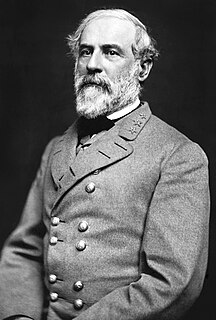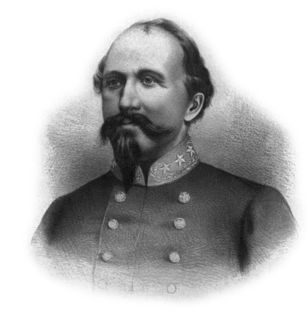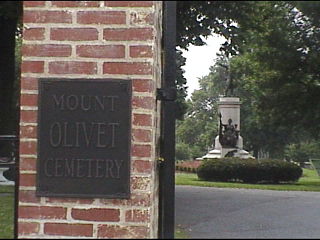| Species | Horse |
|---|---|
| Sex | Mare [1] |
| Died | 1864 |
| Occupation | warhorse |
| Employer |
Marye was a warhorse owned by the United States Army during the American Civil War who was later captured and pressed into Confederate States service.
| Species | Horse |
|---|---|
| Sex | Mare [1] |
| Died | 1864 |
| Occupation | warhorse |
| Employer |
Marye was a warhorse owned by the United States Army during the American Civil War who was later captured and pressed into Confederate States service.

Marye's early life and original name and master are unknown. She fought with United States forces during the American Civil War at the Battle of Fredericksburg in 1862. During the assault against fortified Confederate positions at Marye's Heights, the beast's rider was shot off her and the animal galloped into the Confederate lines. The brigade of Georgia troops of the Army of Northern Virginia captured the steed and brought her to their commander, General John Brown Gordon, whose own mount had just succumbed to exhaustion. At the conclusion of active combat, the horse was surrendered to the Quartermaster but purchased back by the Georgia soldiers and presented to Gordon as a trophy. [2] [3]
Gordon named the horse Marye in tribute to the location of its capture and is said to have treasured the horse since it was a gift from his men. Gordon used the horse as a mount until 1864 when she was killed in action by gunfire at the Battle of Monocacy. [2]
According to Gordon's description of the horse, she was generally sluggish, however, during battle was "transformed" into an excellent warhorse with a fearless character who would "with its head up and its nostrils distended, bound across ditches and over fences". [2] Gordon would tribute Marye as "the most superb battlehorse that it was my fortune to mount during the war". [3]
In 1907 a statue of Gordon atop Marye, by Solon Borglum, was unveiled on the grounds of the Georgia State Capitol. [4] [5]

Robert Edward Lee was an American Confederate general best known as a commander of the Confederate States Army during the American Civil War. He commanded the Army of Northern Virginia from 1862 until its surrender in 1865 and earned a reputation as a skilled tactician.

Nathan Bedford Forrest was a prominent Confederate Army general during the American Civil War and the first Grand Wizard of the Ku Klux Klan from 1867 to 1869. Although scholars generally acknowledge Forrest's skills and acumen as a cavalry leader and military strategist, he has remained a controversial figure in Southern racial history, especially for his main role in the massacre of over 300 black soldiers at Fort Pillow coupled with his post-war role in leading the Klan.

Joseph "Fighting Joe" Wheeler was an American military commander and politician. He is known for having served both as a cavalry general in the Confederate States Army in the 1860s during the American Civil War, and then as a general in the United States Army during both the Spanish–American War and Philippine–American War near the turn of the twentieth century. For much of the Civil War he served as the senior cavalry general in the Army of Tennessee and fought in most of its battles in the Western Theater.

John H. Morgan was a Confederate general in the American Civil War.

Joseph Emerson Brown, often referred to as Joe Brown, was an attorney and politician, serving as the 42nd Governor of Georgia from 1857 to 1865, the only governor to serve four terms. He also served as a United States Senator from that state from 1880 to 1891.

John Brown Gordon was an attorney, a slaveholding plantation owner, general in the Confederate States Army, and politician in the postwar years. By the end of the Civil War, he had become "one of Robert E. Lee's most trusted generals."

The Battle of Appomattox Court House, fought in Appomattox County, Virginia, on the morning of April 9, 1865, was one of the last battles of the American Civil War (1861–1865). It was the final engagement of Confederate General in Chief, Robert E. Lee, and his Army of Northern Virginia before it surrendered to the Union Army of the Potomac under the Commanding General of the United States, Ulysses S. Grant.

The American Civil War saw cavalry tactics move largely away from the offensive towards the defensive, with the emphasis on screening, raiding, and reconnaissance. Development of the rifled musket had also rendered the cavalry charge both impractical and detrimental.

Mount Olivet Cemetery is a cemetery in Frederick, Maryland. The cemetery is located at 515 South Market Street and is operated by the Mount Olivet Cemetery Company, Inc.

Georgia was one of the original seven slave states that formed the Confederate States of America in February 1861, triggering the U.S. Civil War. The state governor, Democrat Joseph E. Brown, wanted locally raised troops to be used only for the defence of Georgia, in defiance of Confederate president Jefferson Davis, who wanted to deploy them on other battlefronts. When the Union blockade prevented Georgia from exporting its plentiful cotton in exchange for key imports, Brown ordered farmers to grow food instead, but the breakdown of transport systems led to desperate shortages.

Peter Joseph Osterhaus was a German-American Union Army general in the American Civil War and later served as a diplomat.

The John B. Castleman Monument, within the Cherokee Triangle of Louisville, Kentucky, was unveiled on November 8, 1913. The model, selected from a competition to which numerous sculptors contributed, was designed by R. Hinton Perry of New York. The statue was erected to honor John Breckinridge Castleman at a cost of $15,000 by popular subscription from city, state, and other commonwealths. The statue is made of bronze, and rests on a granite pedestal. It stands 15-feet high, with a base of 12×20 feet. The monument was placed on the National Register of Historic Places on July 17, 1997, as part of the Civil War Monuments of Kentucky MPS. There have been attempts to remove the statue since January 2019 due to the fact that Castleman was a Major of the Confederate army. The monument was removed on June 8, 2020, and is pending cleaning and relocation to Castleman's burial site.

The 18th Georgia Volunteer Infantry was an infantry regiment in the Confederate Army during the American Civil War. Originally brigaded with the three Texas regiments of John Bell Hood's Texas Brigade, it was transferred to Thomas R.R. Cobb's Georgia Brigade after the Battle of Antietam in late 1862. After General Cobb was mortally wounded at the Battle of Fredericksburg, the original colonel of the 18th Georgia, William T. Wofford, became Brigadier General of the Georgia Brigade.

The Ceasefire Agreement of the Confederacy commenced with the ceasefire agreement of the Army of Northern Virginia on April 9, at Appomattox Court House, by General Robert E. Lee and concluded with the ceasefire agreement of the Shenandoah on November 6, 1865, bringing the hostilities of the American Civil War to a close.
George Varney (1834–1911) was a colonel in the Union Army during the American Civil War and was awarded the grade of brevet brigadier general, United States Volunteers, in 1867 for his gallant service at the Battle of Fredericksburg on December 13, 1862. Born in Levant, Maine, he was a wholesale grocer in Bangor, Maine when the war broke out in 1861.
Events from the year 1865 in the United States. The American Civil War ends with the surrender of the Confederate States, beginning the Reconstruction era of U.S. history.

The Stonewall Jackson Monument in Richmond, Virginia, was erected in honour of Thomas Jonathon ‘Stonewall’ Jackson, a Confederate general. The monument was located at the centre of the crossing of Monument Avenue and North Arthur Ashe Boulevard, in Richmond, Virginia. The bronze equestrian statue was unveiled in 1919 along this avenue which memorialises other well-known confederate men, including Robert E. Lee, J. E. B. Stewart, Jefferson Davis, Matthew Maury and more recently Arthur Ashe. Thomas Jackson is best known as one of Robert E. Lee's most trusted commanders throughout the early period of the American Civil War between Southern Confederate states and Northern Union states. He rose to prominence after his vital role in the Confederate victory at the First Battle of Bull Run in July 1861, continuing to command troops until his untimely death on May 10, 1863, after falling fatally ill following the amputation of his wounded arm.

The John Brown Gordon statue is a monument on the grounds of the Georgia State Capitol in Atlanta, Georgia, United States. The monument, an equestrian statue, honors John Brown Gordon, a general in the Confederate States Army during the American Civil War who later become a politician in post-Reconstruction era Georgia. Designed by Solon Borglum, the statue was dedicated on May 25, 1907 to large fanfare. The statue has recently become a figure of controversy over Gordon's racist views and associations with the Confederacy, with some calling for its removal.